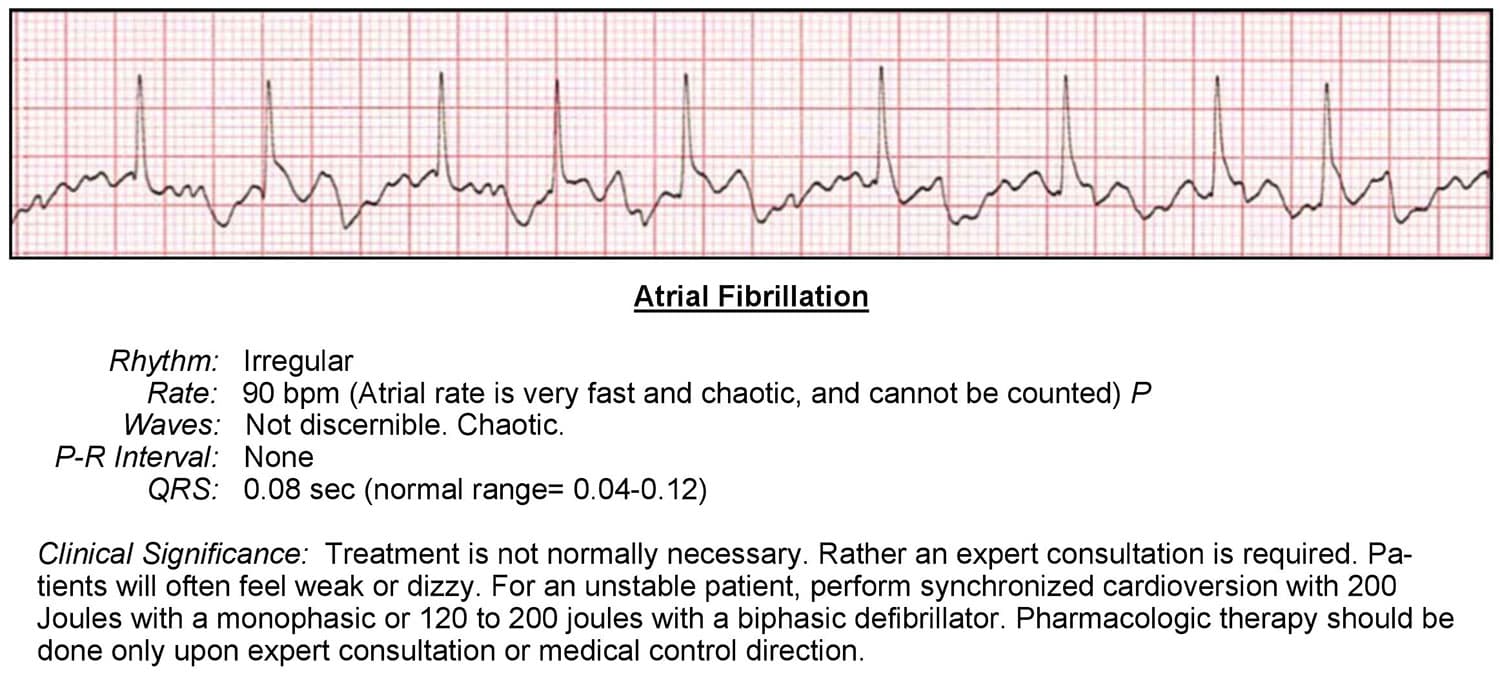There are three primary types of atrial fibrillation:
- Paroxysmal Atrial Fibrillation
- Transient episodes that stop on their own
- May last anywhere from seconds or minutes, to hours or up to a week
- Persistent Atrial Fibrillation
- Episodes last more than a week
- Episodes that last less than a week but are only stopped by either pharmacological or electrical cardioversion
- Long-Standing Persistent Atrial Fibrillation
- Persistent atrial fibrillation that lasts longer than one year
- Formerly known as chronic or permanent atrial fibrillation
Atrial fibrillation is when multiple electrical impulses are being generated in the atria at the same time. This causes chaotic myocardial responses that may diminish both the pre-load and effectiveness of the cardiac contraction.
This can lead to:
- Development of microemboli due to stagnant blood flow from the atria
- Rapid ventricular response secondary to a reentry problem
The electrical pattern will have no discernable P waves. Instead, it will have a fibrillatory wave between each QRS complex. The result is a lack of coordinated electrical impulses from the atria with an irregular ventricular response.

To interpret an ECG, ask the following questions:
Rhythm
- Is the rhythm regular or irregular?
- The rhythm is irregular
Rate
- What is the rate?
- The rate is 80 bpm, but irregular
- Is the rate normal, fast or slow?
- The rate is variable because of its irregularity
P Waves
- Are they present?
- No, the P waves are not present
- Do they occur regularly?
- No, because there are no P waves
- Is there one P wave for each QRS complex?
- No
- Are the P waves smooth, rounded, and upright?
- No
- Do all P waves have similar shapes?
- No
PR Interval
- Does the PR interval fall within the normal 0.12-0.20 seconds?
- No, because there isn’t a PR interval
- Is the PR interval constant?
- This doesn’t apply because there is not a P wave
QRS
- Is the QRS interval less than 0.09 seconds?
- Yes, the QRS is within normal range
- Is the QRS wide or narrow?
- In this case, the QRS is narrow
- Are the QRS complexes similar in appearance?
- Each one looks similar
Cardiac Interpretation
This ECG would indicate atrial fibrillation. There are many possible causes, some of the most common underlying ones are:
- CHF patients or those with a previous history where the patient may have damage to the SA node
- Patient has a conduction system dysfunction from a current or past MI
- Patient has experienced a traumatic injury
- Patient has a disease process
- Patient may have used or still uses harmful drugs
- Patient has a metabolic disorder
Common side effects from atrial fibrillation include, but are not limited to:
- A higher risk for coronary, cerebral, or pulmonary embolism
- A result of the increased potential for microemboli to develop secondary to the lack of circulation of blood from the atria
- Rapid ventricular response to the atrial fibrillation which can accelerate the ventricular rate to above 100 bpm
- Atrial Fibrillation combined with higher ventricular rates may decrease the amount of blood ejected from the heart due to the lack of the preloading Atrial Kick.